|
Pythagorean Means
In mathematics, the three classical Pythagorean means are the arithmetic mean (AM), the geometric mean (GM), and the harmonic mean (HM). These means were studied with proportions by Pythagoreans and later generations of Greek mathematicians because of their importance in geometry and music. Definition They are defined by: :\begin \operatorname \left( x_1,\; \ldots,\; x_n \right) &= \frac \\ pt \operatorname \left( x_1,\; \ldots,\; x_n \right) &= \sqrt \\ pt \operatorname \left( x_1,\; \ldots,\; x_n \right) &= \frac \end Properties Each mean, \operatorname, has the following properties: ; First order homogeneity: \operatorname(bx_1,\, \ldots,\, bx_n) = b \operatorname(x_1,\, \ldots,\, x_n) ; Invariance under exchange: \operatorname(\ldots,\, x_i,\, \ldots,\, x_j,\, \ldots) = \operatorname(\ldots,\, x_j,\, \ldots,\, x_i,\, \ldots) : for any i and j. ; Monotonicity: a < b \rightarrow \operatorname(a,x_1,x_2,\ldots x_n) < \operatorname(b,x_1,x_2,\ldots x_n) ; |
Archytas Of Tarentum
Archytas (; el, Ἀρχύτας; 435/410–360/350 BC) was an Ancient Greek philosopher, mathematician, music theorist, astronomer, statesman, and strategist. He was a scientist of the Pythagorean school and famous for being the reputed founder of mathematical mechanics, as well as a good friend of Plato. Life and work Archytas was born in Tarentum, Magna Graecia and was the son of Mnesagoras or Hadees. For a while, he was taught by Philolaus, and was a teacher of mathematics to Eudoxus of Cnidus. Archytas and Eudoxus' student was Menaechmus. As a Pythagorean, Archytas believed that only arithmetic, not geometry, could provide a basis for satisfactory proofs. Archytas is believed to be the founder of mathematical mechanics.: ''Vitae philosophorum'' As only described in the writings of Aulus Gellius five centuries after him, he was reputed to have designed and built the first artificial, self-propelled flying device, a bird-shaped model propelled by a jet of what was p ... [...More Info...] [...Related Items...] OR: [Wikipedia] [Google] [Baidu] |
Golden Ratio
In mathematics, two quantities are in the golden ratio if their ratio is the same as the ratio of their sum to the larger of the two quantities. Expressed algebraically, for quantities a and b with a > b > 0, where the Greek letter phi ( or \phi) denotes the golden ratio. The constant \varphi satisfies the quadratic equation \varphi^2 = \varphi + 1 and is an irrational number with a value of The golden ratio was called the extreme and mean ratio by Euclid, and the divine proportion by Luca Pacioli, and also goes by several other names. Mathematicians have studied the golden ratio's properties since antiquity. It is the ratio of a regular pentagon's diagonal to its side and thus appears in the construction of the dodecahedron and icosahedron. A golden rectangle—that is, a rectangle with an aspect ratio of \varphi—may be cut into a square and a smaller rectangle with the same aspect ratio. The golden ratio has been used to analyze the proportions of natural object ... [...More Info...] [...Related Items...] OR: [Wikipedia] [Google] [Baidu] |
Average
In ordinary language, an average is a single number taken as representative of a list of numbers, usually the sum of the numbers divided by how many numbers are in the list (the arithmetic mean). For example, the average of the numbers 2, 3, 4, 7, and 9 (summing to 25) is 5. Depending on the context, an average might be another statistic such as the median, or mode. For example, the average personal income is often given as the median—the number below which are 50% of personal incomes and above which are 50% of personal incomes—because the mean would be higher by including personal incomes from a few billionaires. For this reason, it is recommended to avoid using the word "average" when discussing measures of central tendency. General properties If all numbers in a list are the same number, then their average is also equal to this number. This property is shared by each of the many types of average. Another universal property is monotonicity: if two lists of numbers ''A'' and ... [...More Info...] [...Related Items...] OR: [Wikipedia] [Google] [Baidu] |
Neopythagoreanism
Neopythagoreanism (or neo-Pythagoreanism) was a school of Hellenistic philosophy which revived Pythagorean doctrines. Neopythagoreanism was influenced by middle Platonism and in turn influenced Neoplatonism. It originated in the 1st century BC and flourished during the 1st and 2nd centuries AD. The ''Encyclopædia Britannica'' Eleventh Edition describes Neopythagoreanism as "a link in the chain between the old and the new" within Hellenistic philosophy. Central to Neopythagorean thought was the concept of a soul and its inherent desire for a ''unio mystica'' with the divine. The word ''Neopythagoreanism'' is a modern (19th century) term, coined as a parallel of "Neoplatonism". History In the 1st century BC Cicero's friend Nigidius Figulus made an attempt to revive Pythagorean doctrines, but the most important members of the school were Apollonius of Tyana and Moderatus of Gades in the 1st century AD. Other important Neopythagoreans include the mathematician Nicomachus of Gera ... [...More Info...] [...Related Items...] OR: [Wikipedia] [Google] [Baidu] |
Eudemus Of Rhodes
Eudemus of Rhodes ( grc-gre, Εὔδημος) was an ancient Greek philosopher, considered the first historian of science, who lived from c. 370 BCE until c. 300 BCE. He was one of Aristotle's most important pupils, editing his teacher's work and making it more easily accessible. Eudemus' nephew, Pasicles, was also credited with editing Aristotle's works. Life Eudemus was born on the isle of Rhodes, but spent a large part of his life in Athens, where he studied philosophy at Aristotle's Peripatetic School. Eudemus's collaboration with Aristotle was long-lasting and close, and he was generally considered to be one of Aristotle's most brilliant pupils: he and Theophrastus of Lesbos were regularly called not Aristotle's "disciples", but his "companions" (ἑταῖροι). It seems that Theophrastus was the greater genius of the two, continuing Aristotle's studies in a wide range of areas. Although Eudemus too conducted original research, his ''forte'' lay in systematizing Aristotle ... [...More Info...] [...Related Items...] OR: [Wikipedia] [Google] [Baidu] |
Theaetetus (mathematician)
Theaetetus of Athens (; grc-gre, Θεαίτητος; c. 417 – c. 369 BC), possibly the son of Euphronius of the Athenian deme Sunium, was a Greek mathematician. His principal contributions were on irrational lengths, which was included in Book X of Euclid's ''Elements'' and proving that there are precisely five regular convex polyhedra. A friend of Socrates and Plato, he is the central character in Plato's eponymous Socratic dialogue. Theaetetus, like Plato, was a student of the Greek mathematician Theodorus of Cyrene. Cyrene was a prosperous Greek colony on the coast of North Africa, in what is now Libya, on the eastern end of the Gulf of Sidra. Theodorus had explored the theory of incommensurable quantities, and Theaetetus continued those studies with great enthusiasm; specifically, he classified various forms of irrational numbers according to the way they are expressed as square roots. This theory is presented in great detail in Book X of Euclid's ''Elements''. Theae ... [...More Info...] [...Related Items...] OR: [Wikipedia] [Google] [Baidu] |
Pappus Of Alexandria
Pappus of Alexandria (; grc-gre, Πάππος ὁ Ἀλεξανδρεύς; AD) was one of the last great Greek mathematicians of antiquity known for his ''Synagoge'' (Συναγωγή) or ''Collection'' (), and for Pappus's hexagon theorem in projective geometry. Nothing is known of his life, other than what can be found in his own writings: that he had a son named Hermodorus, and was a teacher in Alexandria.Pierre Dedron, J. Itard (1959) ''Mathematics And Mathematicians'', Vol. 1, p. 149 (trans. Judith V. Field) (Transworld Student Library, 1974) ''Collection'', his best-known work, is a compendium of mathematics in eight volumes, the bulk of which survives. It covers a wide range of topics, including geometry, recreational mathematics, doubling the cube, polygons and polyhedra. Context Pappus was active in the 4th century AD. In a period of general stagnation in mathematical studies, he stands out as a remarkable exception. "How far he was above his contemporaries, how lit ... [...More Info...] [...Related Items...] OR: [Wikipedia] [Google] [Baidu] |
Timaeus (dialogue)
''Timaeus'' (; grc-gre, Τίμαιος, Timaios, ) is one of Plato's dialogues, mostly in the form of long monologues given by Critias and Timaeus, written 360 BC. The work puts forward reasoning on the possible nature of the physical world and human beings and is followed by the dialogue ''Critias''. Participants in the dialogue include Socrates, Timaeus, Hermocrates, and Critias. Some scholars believe that it is not the Critias of the Thirty Tyrants who appears in this dialogue, but his grandfather, who is also named Critias. It has been suggested from some traditions (Diogenes Laertius (VIII 85) from Hermippus of Smyrna (3rd century BC) and Timon of Phlius ( 320 – 235 BC)) that ''Timaeus'' was influenced by a book about Pythagoras, written by Philolaus, although this assertion is generally considered false. Introduction The dialogue takes place the day after Socrates described his ideal state. In Plato's works, such a discussion occurs in the ''Republic''. Socrates fe ... [...More Info...] [...Related Items...] OR: [Wikipedia] [Google] [Baidu] |
Plato
Plato ( ; grc-gre, Πλάτων ; 428/427 or 424/423 – 348/347 BC) was a Greek philosopher born in Athens during the Classical period in Ancient Greece. He founded the Platonist school of thought and the Academy, the first institution of higher learning on the European continent. Along with his teacher, Socrates, and his student, Aristotle, Plato is a central figure in the history of Ancient Greek philosophy and the Western and Middle Eastern philosophies descended from it. He has also shaped religion and spirituality. The so-called neoplatonism of his interpreter Plotinus greatly influenced both Christianity (through Church Fathers such as Augustine) and Islamic philosophy (through e.g. Al-Farabi). In modern times, Friedrich Nietzsche diagnosed Western culture as growing in the shadow of Plato (famously calling Christianity "Platonism for the masses"), while Alfred North Whitehead famously said: "the safest general characterization of the European philosophical tra ... [...More Info...] [...Related Items...] OR: [Wikipedia] [Google] [Baidu] |
Hippasus
Hippasus of Metapontum (; grc-gre, Ἵππασος ὁ Μεταποντῖνος, ''Híppasos''; c. 530 – c. 450 BC) was a Greek philosopher and early follower of Pythagoras. Little is known about his life or his beliefs, but he is sometimes credited with the discovery of the existence of irrational numbers. The discovery of irrational numbers is said to have been shocking to the Pythagoreans, and Hippasus is supposed to have drowned at sea, apparently as a punishment from the gods for divulging this. However, the few ancient sources which describe this story either do not mention Hippasus by name (e.g. Pappus) or alternatively tell that Hippasus drowned because he revealed how to construct a dodecahedron inside a sphere. The discovery of irrationality is not specifically ascribed to Hippasus by any ancient writer. Life Little is known about the life of Hippasus. He may have lived in the late 5th century BC, about a century after the time of Pythagoras. Metapontum in Italy (Mag ... [...More Info...] [...Related Items...] OR: [Wikipedia] [Google] [Baidu] |



